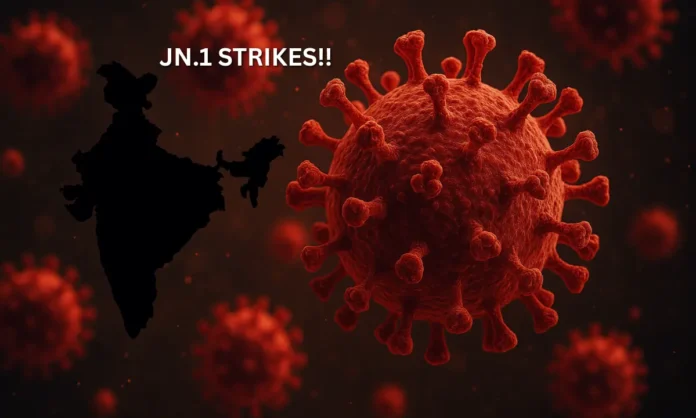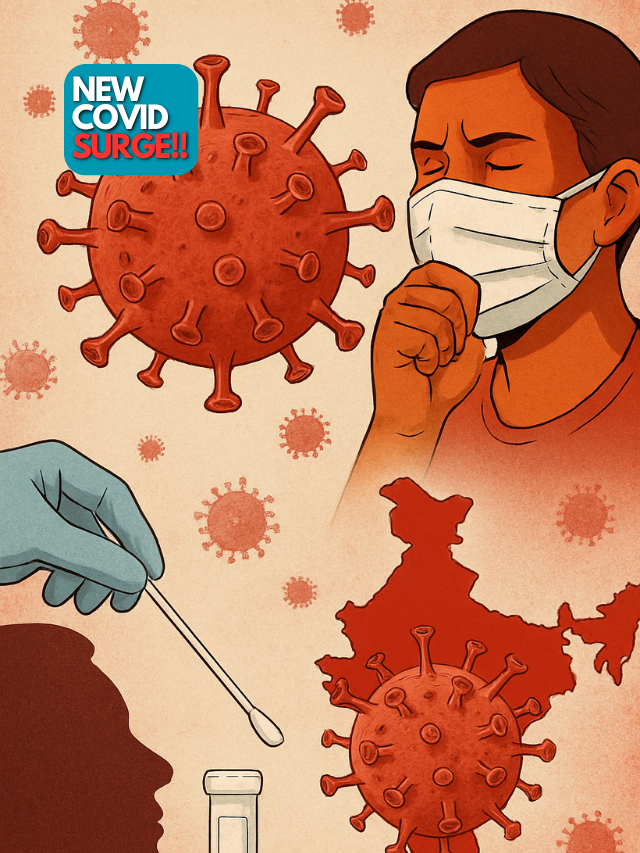Summary
- COVID-19 cases are rising in India, with Kerala reporting the highest spike linked to the new JN.1 Omicron subvariant.
- JN.1 includes a spike protein mutation that may increase transmissibility and help evade prior immunity.
- Most cases remain mild, but authorities urge masks, testing, and vigilance amid potential rapid spread.
A New Variant on Familiar Ground: India’s COVID Resurgence via JN.1
India is once again witnessing a troubling uptick in COVID-19 cases, this time driven by a subvariant that is genetically familiar yet behaviorally unpredictable. The JN.1 variant — a sub-lineage of Omicron — has emerged as the new focal point of concern. Already flagged in multiple Indian states and dominant in Kerala, JN.1 is under close scrutiny for its potential to spread faster or differently than its predecessors.
With over 250 active cases reported nationwide and Kerala alone logging 335 new infections in a single update, health authorities are urging precautionary measures including the return of mask advisories. While the scale of the surge is currently modest, the concern lies in the nature of the JN.1 mutation, which alters the virus’s spike protein — the key that allows it to enter human cells and potentially evade existing immunity.
Though the severity of illness remains low in most cases, India’s densely populated urban centers remain particularly vulnerable to rapid transmission. With lingering fatigue from past waves and vaccination coverage stagnating, JN.1’s timing could test the country’s readiness to contain localized outbreaks — without reigniting widespread panic.
JN.1 Covid Variant Update
— Dr. Mukharjee Madivada (@drmssm) December 22, 2023
^^^^^^^^^^^^^^^^^^
What is JN1?
***************
1. This is a new subvariant of #Omicron Covid variant.
2. Omicron has been evolving: BA.5, #XBB 1.5 (kraken); BA.2.86 (Pirola); EG 5 (Eris) etc.. (none of thenames in the brackets are official).
3.… pic.twitter.com/qMKYYm9jae
JN.1 Explained: What Makes This Variant Different from Omicron
- JN.1 is a sub-lineage of Omicron, marked by a mutation in its spike protein.
- This mutation may enhance its ability to infect cells or bypass immune protection.
- The variant has triggered surges not only in India but also in China, Singapore, and Hong Kong.
The emergence of JN.1 is not simply a reiteration of Omicron — it represents a subtle but potentially consequential evolution of the virus. Scientists are especially focused on its spike protein mutation, which may alter the way the virus attaches to and enters cells, possibly boosting its transmissibility.
Detected first in China and now present in various Indian states, JN.1 is notable for its rapid rise in case numbers. While it shares many clinical features with earlier Omicron variants, such as milder respiratory symptoms and a lower likelihood of hospitalization, its potential for immune evasion raises red flags. Individuals with prior infections or vaccinations may still get infected, albeit with milder outcomes.
As with previous subvariants, speed of spread matters as much as severity. A variant that moves quickly, even if mild, can still stress healthcare systems if left unchecked. That’s why early detection and genomic sequencing are being ramped up across India — especially in Kerala, the current epicenter.
Symptoms, Testing, and Treatment: What the Public Needs to Know
- Symptoms are generally mild: fever, sore throat, congestion, fatigue, and occasionally nausea.
- RT-PCR remains the gold standard for detection, with RATs suitable for quick screening.
- Mild cases can be managed at home, but medical help is advised if oxygen drops or symptoms escalate.
The symptoms associated with JN.1 align with previous Omicron infections, including fever, dry or wet cough, sore throat, congestion, and mild gastrointestinal issues like nausea or diarrhea. Most cases resolve within 5 to 7 days, though older individuals and those with pre-existing conditions may experience prolonged recovery.
For diagnosis, RT-PCR tests are recommended for accuracy, while rapid antigen tests offer quick results in high-exposure environments. However, a negative RAT doesn’t always rule out infection — especially in early stages — so follow-up testing may be necessary.
Treatment advice remains consistent: rest, hydration, steam inhalation, and over-the-counter medication for fever and pain, under medical supervision. If oxygen levels drop below 94% or symptoms worsen, hospital intervention becomes critical. With no evidence yet of increased virulence, early management and monitoring remain the best line of defense.
India’s Strategic Response: Localised Vigilance Without Panic
- Kerala leads in active cases; advisories have been issued for mask-wearing and early testing.
- Past infections may offer partial immunity, but JN.1’s mutation poses reinfection risk.
- The government is monitoring trends closely, balancing alertness with public calm.
India’s current response to the JN.1 outbreak has been measured — a departure from the sweeping lockdowns of past waves. Health ministries have issued advisories rather than mandates, focusing on high-risk groups and states with rising numbers. Kerala, which has reported the majority of active cases, has reintroduced mask recommendations and stepped up surveillance.
The public health challenge now is dual: prevent complacency without inducing fear. With each wave, the virus seems to exploit gaps in both immunity and public discipline. Vaccination campaigns, while still active, are no longer driving urgency. And public perception has largely shifted to view COVID-19 as endemic — potentially making populations more vulnerable to unexpected surges.
Experts caution that while JN.1 isn’t likely to bring back national-scale disruptions, its ability to spread fast and reinfect partially immune populations makes it worth watching. The test for India’s healthcare system isn’t one of endurance anymore — it’s one of adaptability.
Staying Ahead of the Curve: Why the JN.1 Variant Demands Smart Vigilance
The JN.1 variant doesn’t spell a return to crisis — but it does serve as a critical reminder. COVID-19 hasn’t ended. It has simply evolved, as viruses do. The emergence of JN.1, especially in high-density states like Kerala, highlights the need for precision public health — localized responses, real-time genomic surveillance, and timely communication.
With the majority of cases remaining mild and recoverable, the tools for managing this wave already exist. But their effectiveness depends on speed: testing early, treating early, and isolating when needed. The real risk now is not medical unpreparedness, but societal inertia.
India has come a long way since the chaos of 2020 and 2021. The question now is whether that progress will hold in the face of quieter, subtler threats like JN.1 — variants that don’t shout, but whisper their danger into the population. Listening to those whispers may make all the difference.



